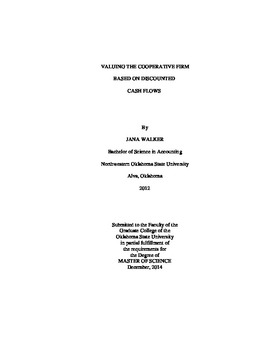| dc.contributor.advisor | Kenkel, Phil | |
| dc.contributor.author | Walker, Jana Alison | |
| dc.date.accessioned | 2016-01-20T15:45:09Z | |
| dc.date.available | 2016-01-20T15:45:09Z | |
| dc.date.issued | 2014-12-01 | |
| dc.identifier.uri | https://hdl.handle.net/11244/25732 | |
| dc.description.abstract | The stock in a cooperative firm is not publically traded but is instead redeemed by the cooperative at book value at some future point in time. This structure eliminates an observable stock price than can be used to infer the value of the firm. Firm value is not generally an important issue for cooperative members but valuation can become critical when members are faced with an outside offer to buy the firm or the cooperative is considering merger with another cooperative. Currently, most cooperative firms are evaluated based on their business assets, with the valuation often based on the historical value on the balance sheet. This can create several issues for the cooperative members. This paper proposed a method of valuing cooperatives based on the discounted projected cash flows. The main purpose of this research is to determine how this method, which is used in other situations, can be applied to the cooperative firm. A six year time series of financial and operating data was obtained for 10 representative Oklahoma cooperatives. In addition to complete financial data the information included data on the physical units of grain, fertilizer and petroleum handled and patron equity records. A cooperative financial simulation program developed at Oklahoma State University was used to develop 10 year projections for the case study cooperatives. The simulations modeled the sales, expenses, profits and profit distributions of the firm and considered the cash flow required for infrastructure reinvestment and equity retirement. The financial projections were used to project the free cash flows of the cooperatives which were then discounted to provide a valuation according to standard methods. In the base case, we found that the future cash flow to equity (FCFE) final value on average was approximately 5.31 times the value of the member's allocated equity while the member value (MV) was approximately 1.88 times the value of the allocated equity and the balance sheet valuation was 2.75 times the value of allocated equity. This implies that the group of case study cooperatives are creating substantial value from their member's investments. | |
| dc.format | application/pdf | |
| dc.language | en_US | |
| dc.publisher | Oklahoma State University | |
| dc.rights | Copyright is held by the author who has granted the Oklahoma State University Library the non-exclusive right to share this material in its institutional repository. Contact Digital Library Services at lib-dls@okstate.edu or 405-744-9161 for the permission policy on the use, reproduction or distribution of this material. | |
| dc.title | Valuing the Cooperative Firm Based on Discounted Cash Flows | |
| dc.type | text | |
| dc.contributor.committeeMember | Jones, Rodney | |
| dc.contributor.committeeMember | Doye, Damona Grace | |
| osu.filename | Walker_okstate_0664M_13707.pdf | |
| osu.accesstype | Open Access | |
| dc.description.department | Agricultural Economics | |
| dc.type.genre | Thesis | |
